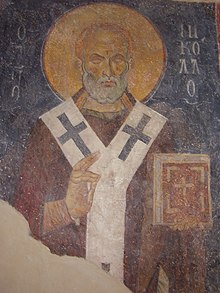Sweti Georgi (Kyustendil)

The Church of Sweti Georgi ( Bulgarian Свети Георги , dt. Saint George) of the Bulgarian Orthodox Church in the western Bulgarian town of Kyustendil is one of the oldest preserved church buildings in the Bulgarian and European southeast . The church is an architectural and artistic cultural monument of national importance. It is dedicated to St. George .
location
The Sweti Georgi Church is located in the southwestern part of Kyustendil, in the Kolusha district (medieval village Kolasia), on the slope of the Osogowo Mountains, around 90 km southwest of the Bulgarian capital Sofia . Kolasia was the seat of a metropolitan in the Middle Ages .
history
Today's Sweti Georgi Church is a cross-domed church with a small porch ( esonarthex ). The church building is approx. 10 m long and approx. 9 m wide. The church was built on stone foundations with bricks.
Due to its architectural peculiarities and the recently discovered medieval wall paintings, the building is dated to the turn of the 10th to the 11th century. Frescoes from the 12th, 15th and 17th centuries were also discovered.
It is believed that the grave of the Bulgarian Tsar Mikhail III, who was killed in the battle of Welbashd in 1330 . Schischman was here.
In the 19th century the church was destroyed down to the arches by the Ottoman Turks . After the liberation of Bulgaria in the years 1878-1880, it was rebuilt with Djado Stojan as ktitor . Since it was used for worship services, a cloister , a bell tower and a portico (colonnade) were also built. The interior and exterior walls of the church were newly plastered and repainted by masters from the Samokow Art School .
restoration
The first scientific research was carried out in 1906 by Jordan Ivanov . He was followed by André Grabar in 1921 and Nikola Mawrodinow in 1931.
From 1974 to 1976, Plamen Petrow directed the first restoration of the church. From 1979 to 1985 the work of Christina Stanewa and Ljuba Krasowska was continued. After 1990 they were directed by Albena Masakowa and from 2004 by Borjana Dschiwdanowa.
In 1985 the portico, the bell tower and the newer frescoes were removed. This gave the church back its medieval appearance.
In 1990 the medieval frescoes were fully exposed. The restoration of the church was completed in 2004.
Frescoes

The medieval frescoes were painted by painters from the Thessaloniki School. The iconography merged with the Bulgarian traditions of the Second Bulgarian Empire and the Tarnovo School . In the wall paintings, in addition to Saints Pantelejmon , Ermolaj, Damjan and Kozma , Mina, Saint Barbara , Nedelja, Ekaterna and Saint Petka of Bulgaria are also present. The best preserved fresco depicts St. Nicholas of Myra . The icons of Sava of Serbia and Ioanes Babtijski from the 15th and 16th centuries are well preserved.
The medieval wall paintings preserved there are rare monuments of Byzantine monumental painting in Bulgaria and expand our knowledge of Bulgarian church painting of that time. The church is of great historical, artistic and architectural value.
The frescoes from the time of the Bulgarian rebirth at the end of the 19th century, which were removed during the restoration , were exhibited together in a specially built museum which is located in the immediate vicinity. They are among the best preserved examples of the Samokov fresco school, which was active in the European part of the Ottoman Empire.
literature
- Albena Mosakowa: Проучване, реставрация и експониране на средновековните стенописи в черкватуа ". Код Георги"., СвК Георги ",. Паметници, реставрация, музеи, 2006, issue 01–02
- Albena Mosakowa: Проучване, реставрация и експониране на средновековните стенописи в църква "Св. Георги “, Колуша, Кюстендил. In: Известия на Исторически музей, Kyustendil. Volume 14, 2007
- André Grabar : Няколко средновековни паметници из Западна България. ГНМ, 1921 г.
- Asen Tschilingirow: Църквата "Свети Герман до Преспанското езеро", Berlin, 2001, pp. 167-171
- Asen Vasilev: Художествени паметници и майстори от Трънско, брезнишко и Кюстендилско - комплексна експедиция 1957-58, Sofia, 1961 г.
- Desislawa Strachilowa: За някои особености на състоянието на църковната живопис в Кюстендил и Кюстендилско през епохата на националното Възраждане Online Version
- Jordan Ivanov: Северна Македония. Исторически издирванияя, Sofia, 1906
- Jordan Sakhariev: Кюстендилската котловина, Sofia, 1963 г., изд. БАН.
- Енциклопедичен речник Кюстендил А-Я, Sofia, 1988 г., изд. БАН.
- Ilija Nikolow: Сваляне на късните стенописи от западната фасада на църквата “Св. Георги ”в квартал Колуша, In: Известия на Исторически музей, Kyustendil. Т.II. 1990.
- Liljana Mawrodinowa: Новооткрити средновековни стенописи в църквата "Св.Георги" в Колуша, Кюстендил in Староселур 1991
- Liliana Mawrodinowa: Стенната живопис в България до края на XIV век, Sofia, 1995
- Liljana Mawrodinowa: Още за средновековната църква в Колуша, Кюстендил / Ктитори, светец-покровител, светец-покровител покровител покровител покровител. In: Известия на Исторически музей, Кюстендил. 14, 2007
- Margarita Koewa: Архитектура на Второто българско царство (to German about The Architecture of the Second Bulgarian Empire) Online version
- Nikola Mawrodinow: Еднокорабната и кръстовидната църква по българските земи до края на XIV век.
Web links
- List of monuments in the Kyustendil municipality ( memento of July 12, 2011 in the Internet Archive ) (Bulgarian and English)
- Kyustendil. Saint George Medieval Church, town of Kyustendil. Digital Culture for Regional Cohesion (Photos)
Coordinates: 42 ° 16 ′ 14.2 " N , 22 ° 40 ′ 37" E
